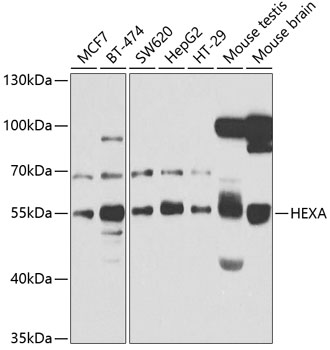Anti-HEXA Antibody (CAB5646)
- SKU:
- CAB5646
- Product type:
- Antibody
- Reactivity:
- Human
- Mouse
- Host Species:
- Rabbit
- Isotype:
- IgG
- Antibody Type:
- Polyclonal Antibody
- Research Area:
- Cell Biology
Description
| Antibody Name: | Anti-HEXA Antibody |
| Antibody SKU: | CAB5646 |
| Antibody Size: | 20uL, 50uL, 100uL |
| Application: | WB |
| Reactivity: | Human, Mouse |
| Host Species: | Rabbit |
| Immunogen: | Recombinant fusion protein containing a sequence corresponding to amino acids 270-529 of human HEXA (NP_000511.2). |
| Application: | WB |
| Recommended Dilution: | WB 1:500 - 1:2000 |
| Reactivity: | Human, Mouse |
| Positive Samples: | MCF7, BT-474, SW620, HepG2, HT-29, Mouse testis, Mouse brain |
| Immunogen: | Recombinant fusion protein containing a sequence corresponding to amino acids 270-529 of human HEXA (NP_000511.2). |
| Purification Method: | Affinity purification |
| Storage Buffer: | Store at -20°C. Avoid freeze / thaw cycles. Buffer: PBS with 0.02% sodium azide, 50% glycerol, pH7.3. |
| Isotype: | IgG |
| Sequence: | IPGL LTPC YSGS EPSG TFGP VNPS LNNT YEFM STFF LEVS SVFP DFYL HLGG DEVD FTCW KSNP EIQD FMRK KGFG EDFK QLES FYIQ TLLD IVSS YGKG YVVW QEVF DNKV KIQP DTII QVWR EDIP VNYM KELE LVTK AGFR ALLS APWY LNRI SYGP DWKD FYIV EPLA FEGT PEQK ALVI GGEA CMWG EYVD NTNL VPRL WPRA GAVA ERLW SNKL TSDL TFAY ERLS HFRC ELLR RGVQ AQPL NVGF CEQE FEQT |
| Gene ID: | 3073 |
| Uniprot: | P06865 |
| Cellular Location: | Lysosome |
| Calculated MW: | 19kDa/60kDa |
| Observed MW: | 55kDa |
| Synonyms: | HEXA, TSD |
| Background: | This gene encodes a member of the glycosyl hydrolase 20 family of proteins. The encoded preproprotein is proteolytically processed to generate the alpha subunit of the lysosomal enzyme beta-hexosaminidase. This enzyme, together with the cofactor GM2 activator protein, catalyzes the degradation of the ganglioside GM2, and other molecules containing terminal N-acetyl hexosamines. Mutations in this gene lead to an accumulation of GM2 ganglioside in neurons, the underlying cause of neurodegenerative disorders termed the GM2 gangliosidoses, including Tay-Sachs disease (GM2-gangliosidosis type I). Alternative splicing results in multiple transcript variants, at least one of which encodes a preproprotein that is proteolytically processed. |
| UniProt Protein Function: | HEXA: Responsible for the degradation of GM2 gangliosides, and a variety of other molecules containing terminal N-acetyl hexosamines, in the brain and other tissues. The form B is active against certain oligosaccharides. The form S has no measurable activity. Defects in HEXA are the cause of GM2-gangliosidosis type 1 (GM2G1); also known as Tay-Sachs disease. GM2- gangliosidosis is an autosomal recessive lysosomal storage disease marked by the accumulation of GM2 gangliosides in the neuronal cells. GM2G1 is characterized by GM2 gangliosides accumulation in the absence of HEXA activity, leading to neurodegeneration and, in the infantile form, death in early childhood. GM2G1 has an increased incidence among Ashkenazi Jews and French Canadians in eastern Quebec. It exists in several forms: infantile (most common and most severe), juvenile and adult (late onset). Belongs to the glycosyl hydrolase 20 family. |
| UniProt Protein Details: | Protein type:Glycan Metabolism - glycosphingolipid biosynthesis - ganglio series; Glycan Metabolism - glycosaminoglycan degradation; Carbohydrate Metabolism - amino sugar and nucleotide sugar; Hydrolase; Glycan Metabolism - other glycan degradation; Glycan Metabolism - glycosphingolipid biosynthesis - globo series; EC 3.2.1.52 Chromosomal Location of Human Ortholog: 15q24.1 Cellular Component: lysosomal lumen; membrane Molecular Function:protein heterodimerization activity; beta-N-acetylhexosaminidase activity Biological Process: keratan sulfate metabolic process; chondroitin sulfate metabolic process; sphingolipid metabolic process; glycosaminoglycan metabolic process; chondroitin sulfate catabolic process; carbohydrate metabolic process; glycosphingolipid metabolic process; pathogenesis; keratan sulfate catabolic process; hyaluronan metabolic process; hyaluronan catabolic process Disease: Tay-sachs Disease |
| NCBI Summary: | This gene encodes the alpha subunit of the lysosomal enzyme beta-hexosaminidase that, together with the cofactor GM2 activator protein, catalyzes the degradation of the ganglioside GM2, and other molecules containing terminal N-acetyl hexosamines. Beta-hexosaminidase is composed of two subunits, alpha and beta, which are encoded by separate genes. Both beta-hexosaminidase alpha and beta subunits are members of family 20 of glycosyl hydrolases. Mutations in the alpha or beta subunit genes lead to an accumulation of GM2 ganglioside in neurons and neurodegenerative disorders termed the GM2 gangliosidoses. Alpha subunit gene mutations lead to Tay-Sachs disease (GM2-gangliosidosis type I). [provided by RefSeq, Jul 2009] |
| UniProt Code: | P06865 |
| NCBI GenInfo Identifier: | 311033393 |
| NCBI Gene ID: | 3073 |
| NCBI Accession: | P06865.2 |
| UniProt Secondary Accession: | P06865,Q53HS8, Q6AI32, B4DKE7, E7ENH7, |
| UniProt Related Accession: | P06865 |
| Molecular Weight: | 529 |
| NCBI Full Name: | Beta-hexosaminidase subunit alpha |
| NCBI Synonym Full Names: | hexosaminidase A (alpha polypeptide) |
| NCBI Official Symbol: | HEXA |
| NCBI Official Synonym Symbols: | TSD |
| NCBI Protein Information: | beta-hexosaminidase subunit alpha; hexosaminidase subunit A; beta-N-acetylhexosaminidase subunit alpha; N-acetyl-beta-glucosaminidase subunit alpha |
| UniProt Protein Name: | Beta-hexosaminidase subunit alpha |
| UniProt Synonym Protein Names: | Beta-N-acetylhexosaminidase subunit alpha; Hexosaminidase subunit A; N-acetyl-beta-glucosaminidase subunit alpha |
| Protein Family: | Hexamerin |
| UniProt Gene Name: | HEXA |
| UniProt Entry Name: | HEXA_HUMAN |







